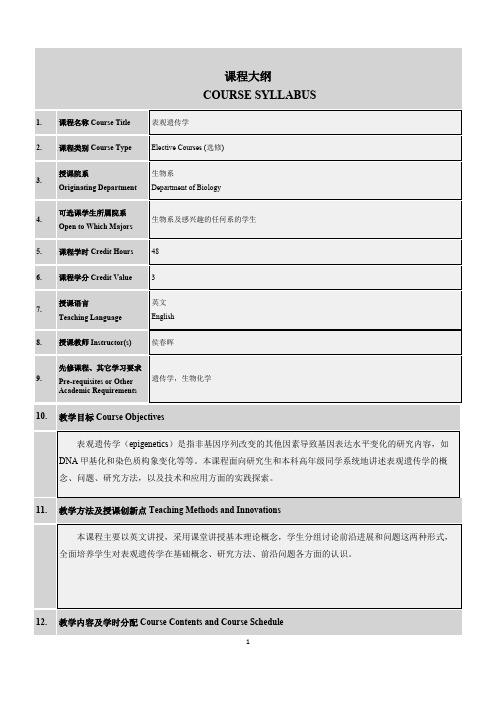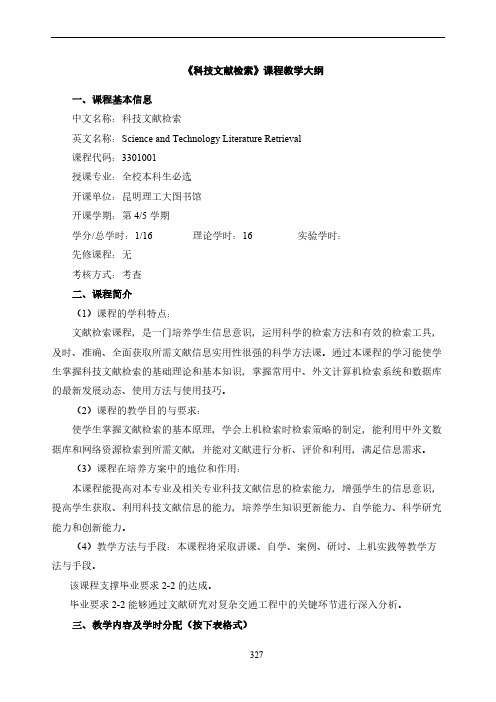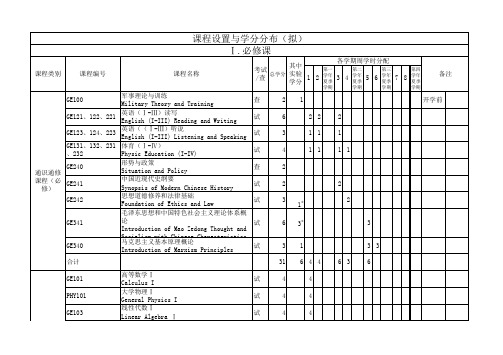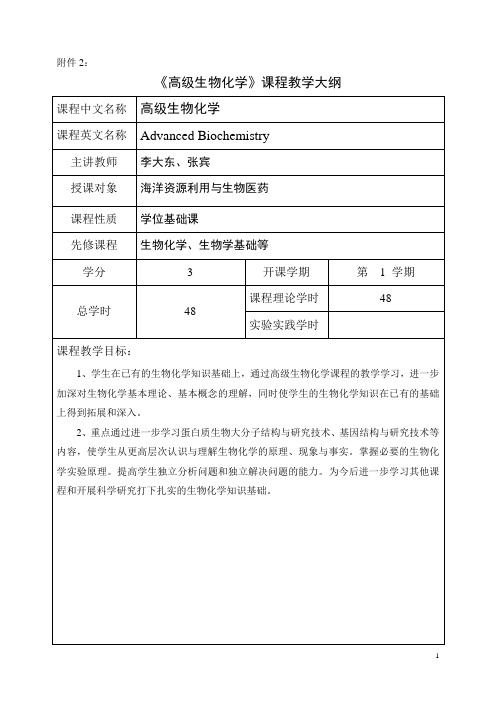南方科技大学 课程教学大纲_Advanced_Biological Sciences 160613
[课程教学大纲]《高级生物物理》
![[课程教学大纲]《高级生物物理》](https://img.taocdn.com/s3/m/632934721711cc7931b7164f.png)
理学院研究生《高级生物物理》课程教学大纲课程编号:课程中文名称:高级生物物理课程英文名称:Advanced Biophysics总学时:60 总学分:3 实验学时:0 讲授学时:60 开课学期:春秋√主要适用专业及学位层次:生物物理专业硕士以及硕博连读生。
必备基础知识及先修课程:具备普通物理学、高等数学、生物化学等学科基础知识。
先修生物物理学、分子生物学、高级植物生理、高级生物化学等课程。
参考教材:1.《生物物理学》丘冠英等编著,武汉大学出版社,2000年。
2.《生物物理学》赵南明、周海梦主编(2000第一版,高等教育出版社)推荐参考书及期刊:1.《生物物理学》赵南明、周海梦主编(2000第一版,高等教育出版社、施普林格出版社)2.《生物物理学》林克椿编著(1999第一版,华中师范大学出版社)3.《简明生物物理学》刘文龙主编(1994年第一版,高等教育出版社)4.《生物物理学》程极济、林克椿主编(1981 第一版,高等教育出版社)5.《生物物理学引论》G. 西伯斯马著,科学出版社,2002年。
6.《生物物理学报》中国生物物理学会主办。
7.《生物化学与生物物理进展》中国生物物理学会主办。
8.《生物物理与生物化学学报》中国科学院主办。
一、课程目的及要求生物物理学是应用物理学的概念和方法研究生物各层次结构与功能的关系,生命活动的物理、物理化学过程,以及物质在生命活动过程中表现的物理特性的生物学分支学科。
生物物理学旨在阐明生物在一定的空间、时间内有关物质、能量与信息的运动规律。
1.通过学习本课程,应达到以下基本要求:(1)掌握生物物理学的物理基础,了解生物组织的基本物理特性;(2)理解生命过程的基本物理规律;(3)了解环境物理因素的基本生物学效应。
2.通过学习本课程,应具备以下能力:(1)初步具备应用物理模型简化复杂生命有机体的“建模”能力。
(2)初步具备应用科学的物理思维方法分析处理生命系统物理运动、总结其基本规律的能力。
《生物技术专业英语与文献检索》课程教学大纲.doc

《生物技术专业英语与文献检索》课程教学大纲课程代码:课程名称:生物技术专业英语与文献检索课程类型:必修课总学时:36 讲课学时:36 实验学时:0学分:2适用对象:生物技术专业本科先修课程:一、课程性质、目的和任务《专业英语》是学生完成了两年基础英语学习后的一门后继课程。
通过指导学生阅读生物技术专业的英语书刊和文献,使他们进一步提高阅读和翻译科技英语的能力,并能以英语为工具获取专业所需的信息。
在科技领域,英语的重要性日益突出,生物技术领域尤为如此:生物技术领域的重要期刊,人都要求以英语发表;本领域国际会议都以英语为工作语言。
本课程的主要任务是:1.介绍生物技术专业词汇的基本构词法,帮助学生掌握一定数量的专业词汇;2.挑选生物技术领域的经典实验资料和学术论文讲解,培养学生对专业英语的阅读与写作能力。
《文献检索》是科学研究过程屮的最为关键的部分之一,非常耗费时间和精力。
据统计,传统的研究屮人约三分之一的工作吋间是在查阅资料・学习文献检索,即学习如何在最短的吋I'可内,以最有效的方式,查找到准确可靠的文献信息。
本课程的主要任务是要让学生掌握获取所需专业资料的种种检索方法和途径。
二、教学基本要求通过本课程的教学,要使学生能基本准确地阅读本专业的英语科技论文,掌握一•定数量的专业英语词汇,具备快速查询获得所需要的本专业屮英文文献的能力。
三、教学内容及要求《专业英语》授课学时Direct1. 熟悉专业词汇构词法(词根、前后缀等),掌握500〜800常用专业词汇。
2. 了解翻译理论知识,掌握务种翻译技巧,重点放在长句、复杂句及难句的翻译3.在规定时间内,能以规范、流畅、通俗易懂的译文语言翻译本专业文章。
《文献检索》 1.掌握学校购买的各种免费数据库的使用方法:CNKI 、Elsevier 公口 1的Science Online 和Springer 电子期刊。
2. 掌握网上免费的NCBI + PLBMED 和PMC 、GOOGLESCHOLAR 的使用方法。
高级生物化学课程大纲

《高级生物化学》课程教学大纲英文译名:Advanced Biochemistry适用专业:生物学、化学工程、应用化学与工程技术学分数:3学分总学时数:54学时一、本课程教学目的和任务本课程是生物学各研究方向研究生的学位课程。
生物化学是前沿理论研究的基础和高科技应用研究的基础,它从化学层面,介绍生物分子的组成、结构与功能,在分子水平上揭示生命现象的运动和变化规律。
通过对高级生物化学的系统学习,使学生牢固掌握生物化学的基本理论和基础知识,为今后应用生物化学的研究成就对生物体进行不同层次的设计、控制、改造、模拟并产生出巨大的生产能力奠定基础。
二、本课程的基本要求要求学生查阅各种文献、运用网络资源、撰写文献综述、翻译最新研究进展等方法进行本课程的学习,以反映当代生物化学的研究进展及成就,使学生在学习基础知识的同时,通过中外文献“窗口”看到学科发展的前沿、看到其基础知识的延伸及与其他相关学科的密切联系,使学生在学习基础知识的同时获得大量的最新信息,满足和激发学生的求知欲和主动学习的兴趣。
三、本课程与其他课程的关系以分子生物学、细胞生物学、微生物学、免疫生物学、人体生理学、动物生理学、植物生理学、微生物生理学、生物化学、生物物理学、遗传学等几乎所有生物学科的次级学科为支撑。
结合化学、化学工程学、数学、微电子技术、计算机科学等生物学领域之外的尖端基础学科,其中又以生命科学领域的重大理论和技术的突破为基础。
五、其他课程作业:翻译外文文献。
资料查阅:查阅国内外最新研究进展。
课程论文:1篇文献综述。
六、选用教材及主要参考书1、教材:[美] B.B.布坎南,W.格鲁依森姆,R.L 琼斯等主编. 植物生物化学与分子生物学. 科学出版社, 20042、参考书:李关荣,高级生物化学,西南师范大学出版社,2010年王镜岩,生物化学(第三版,上下册),高等教育出版社,2004年张洪渊,生物化学原理(国家“十一五”规划教材),科学技术出版社,2006年王艳萍,生物化学(高等教育“十二五”规划教材),中国轻工业出版社,2013年黄熙泰,现代生物化学(高等教育“十一五”国家级规划教材),化学工业出版社,2014年杨荣武,生物化学(高等教育“十二五”规划教材),科学出版社,2013年陈彻,生物化学(英文版),高等教育出版社,2013年赵宝昌,生物化学(英文版),吉林科学技术出版社,2005年汪世龙,蛋白质化学,同济大学出版社,2012年李冠一,核酸化学,科学出版社,2007。
南方科技大学 课程教学大纲-表观遗传学-侯春晖

课程大纲COURSE SYLLABUS1. 课程名称Course Title 表观遗传学2. 课程类别Course Type Elective Courses (选修)3. 授课院系Originating Department生物系Department of Biology4. 可选课学生所属院系Open to Which Majors生物系及感兴趣的任何系的学生5. 课程学时Credit Hours 486. 课程学分Credit Value 37. 授课语言Teaching Language英文English8. 授课教师 Instructor(s) 侯春晖9. 先修课程、其它学习要求Pre-requisites or OtherAcademic Requirements遗传学,生物化学10. 教学目标Course Objectives表观遗传学(epigenetics)是指非基因序列改变的其他因素导致基因表达水平变化的研究内容,如DNA甲基化和染色质构象变化等等。
本课程面向研究生和本科高年级同学系统地讲述表观遗传学的概念、问题、研究方法,以及技术和应用方面的实践探索。
11. 教学方法及授课创新点 Teaching Methods and Innovations本课程主要以英文讲授,采用课堂讲授基本理论概念,学生分组讨论前沿进展和问题这两种形式,全面培养学生对表观遗传学在基础概念、研究方法、前沿问题各方面的认识。
12. 教学内容及学时分配Course Contents and Course Schedule1.History and Overview2.Histone Modifications (Writers, Readers and Erasers)3.Histone Variants4.DNA Methylation5.Transcriptional Silencing6.Genomic Imprinting7.Dosage Compensation8.Nucleosome Remodeling9.Long-Range Chromatin Interactions10.RNA and Chromatin State11.Epigenetic Regulation in Plant12.Epigenetics in Model Systems13.Epigenetics and Induced Pluripotency14. Epigenetics and Immunity15.Epigenetics and Human Disease13. 课程考核Course Assessment文献报告 10%期中考试 30%小测验 20%期末考试 40%14. 教材及其它参考资料Textbook and Supplementary Readings教材主要参考“Epigenetics, second edition”,由C. David Allis等人主编,同时选择最新相关各领域的重要研究论文为教学讨论材料。
2024版《高级生物化学二》课程教学大纲[1]
![2024版《高级生物化学二》课程教学大纲[1]](https://img.taocdn.com/s3/m/cd045c642bf90242a8956bec0975f46527d3a705.png)
测生物分子,如血糖、尿酸等。
24
生物化学技术在药物研发中的应用
2024/1/28
药物靶点的发现与验证
利用生物化学技术寻找和验证药物作用的靶点,为新药研发提供 方向。
药物设计与优化
基于靶点结构和作用机制,设计和优化药物分子结构,提高药物的 疗效和降低副作用。
药物代谢和药代动力学研究
研究药物在体内的吸收、分布、代谢和排泄过程,为药物的临床应 用提供科学依据。
期末考试成绩整体良好,表明学生对课程内容掌握得 较为扎实。
2024/1/28
29
对未来生物化学领域发展的展望
生物化学与医学的深度融合
随着生物医学的不断发展,生物化 学将在疾病诊断、治疗及预防等方 面发挥更加重要的作用。
生物化学与生物工程的结合
利用生物化学技术改良和优化生物 工程过程,提高生物工程产品的质 量和产量。
03
氨基酸代谢
包括氨基酸的脱氨基作用、转氨基作 用等,实现氨基酸的分解和转化。
代谢调控
生物小分子的代谢受到基因表达、酶 活性、激素等多种因素的调控,以维 持生物体内环境的稳定。
05
04
核苷酸代谢
包括嘌呤和嘧啶的合成与分解代谢, 参与核酸的合成与降解。
2024/1/28
13
生物小分子在生命活动中的作用
2024/1/28
生物化学在新能源领域的应用
探索生物化学在新能源领域的应用 潜力,如生物燃料电池、生物质能 转化等,为可持续发展做出贡献。
生物化学在环境保护中的应用
利用生物化学方法处理环境污染问 题,如废水处理、土壤修复等,为 环境保护提供新的解决方案。
30
THANKS
感谢观看
2024/1/28
《科技文献检索》教学大纲

《科技文献检索》课程教学大纲一、课程基本信息中文名称:科技文献检索英文名称:Science and Technology Literature Retrieval课程代码:3301001授课专业:全校本科生必选开课单位:昆明理工大图书馆开课学期:第4/5学期学分/总学时:1/16 理论学时:16 实验学时:先修课程:无考核方式:考查二、课程简介(1)课程的学科特点:文献检索课程,是一门培养学生信息意识,运用科学的检索方法和有效的检索工具,及时、准确、全面获取所需文献信息实用性很强的科学方法课。
通过本课程的学习能使学生掌握科技文献检索的基础理论和基本知识,掌握常用中、外文计算机检索系统和数据库的最新发展动态、使用方法与使用技巧。
(2)课程的教学目的与要求:使学生掌握文献检索的基本原理,学会上机检索时检索策略的制定,能利用中外文数据库和网络资源检索到所需文献,并能对文献进行分析、评价和利用,满足信息需求。
(3)课程在培养方案中的地位和作用:本课程能提高对本专业及相关专业科技文献信息的检索能力,增强学生的信息意识,提高学生获取、利用科技文献信息的能力,培养学生知识更新能力、自学能力、科学研究能力和创新能力。
(4)教学方法与手段:本课程将采取讲课、自学、案例、研讨、上机实践等教学方法与手段。
该课程支撑毕业要求2-2的达成。
毕业要求2-2能够通过文献研究对复杂交通工程中的关键环节进行深入分析。
三、教学内容及学时分配(按下表格式)四、成绩评定方法及要求科技文献检索课程成绩由平时成绩(考勤、课后作业、随堂测试)、实习报告成绩构成。
评定方法为:1.平时成绩(30%)+上机实习报告(70%)。
2.平时成绩:考勤(30%)+课后作业、随堂测试(70%)。
3.期末考核:上机检索实习报告五、参考教材和资料[1]祁延莉.信息检索概论第2版. 北京:北京大学出版社. 2013.[2]马林山.信息检索与利用. 安徽:安徽科学技术出版社.2013.[3]程娟. 信息检索第2版. 天津:天津大学出版社.2014.[4]乔颖.信息检索实用指南. 北京:中国农业科学技术出版社.2013[5]和正荣等. 信息检索与利用.重庆:重庆大学出版社.2000[6]张萍等.信息资源检索教程.吉林:吉林大学出版社.2007年[7]黎文.经济管理文献与信息检索-21世纪高等院校经济管理实验实践教材.广东:华南理工大学出版社.2008[8]黄亚男.信息检索与利用. 湖南:中南大学出版社.2009[9]高祀亮,顾海明.人文社科信息检索. 北京:社会科学文献出版社.2010。
Ⅰ必修课课程设置与学分分布(拟) - 南方科技大学

(必修)
MSE305 MAE305 MAE308 合计
材料力学 Mechanics of Materials 工程热力学 Engineering Thermodynamics 传热学 Heat Transfer
试 试 试
2 3 3 26 5 6 5 7
2 3 3 # 3
材料 力学 二选一 力学
注:1.ME102 CAD与工程制图为春、秋季学期重复开课,因此在学分总计中只算一个3学分。 2.MAE305工程热力学和MAE308传热学两门课均修,则其中三学分计为工程基础必修学分,三学分计为工程基础选修学分。 ME303 ME302 机械工程 专业基础 ME306 (必修) ME304 合计 ME401 ME403 ME405 机械工程 专业方向 ME407 (必修) ME409 ME411 合计 信号分析* 智能机器人技术* 创新设计理论与实践* 精密加工技术* 化学燃料电池技术* 新能源技术* 试 试 试 试 试 试 机械设计基础 Fundamentals 机械制造基础 Fundamentals 机器人基础 Fundamentals 能源工程基础 Fundamentals of Machine Design of Machine Manufacturing of Robotics of Energy Engineering 试 试 试 试 3 3 3 3 12 3 3 3 3 3 3 18 1 1 2 1 1 1 1 1 1 6 3 3 4 4 3 # 4 4 4 多选二 4 4 4 #
课程设置与学分分布(拟) Ⅰ.必修课
课程类别 课程编号 课程名称 其中 考试 总学分 实验 /查 1 2 学分 查 试 试 试 查 试 试 试 试 2 6 3 4 2 2 3 6 3 31 高等数学Ⅰ Calculus I 大学物理Ⅰ General Physics I 线性代数Ⅰ Linear Algebra Ⅰ 试 试 试 4 4 4 1 3
高级生物化学课程教学大纲

5.3 DNA克隆
5.4克隆基因的表达
5.5基因工程
第6章:生物无机化学及研究(8学时)
6.1生物无机化学概念及研究内容
6.2配合物理论
6.3生物金属的生物功能
6.4专题:多糖(蛋白质)-金属配合物研究进展
第7章:机动模块:系统生物学和生物网络(6学时)
7.1系统生物学和生物网络简介
高级生物化学课程教学大纲课程中文名称高级生物化学课程英文名称advancedbiochemistry主讲教师李大东张宾授课对象海洋资源利用与生物医药课程性质学位基础课先修课程生物化学生物学基础等学分3开课学期第1学期总学时48课程理论学时48实验实践学时课程教学目标
附件2:
《高级生物化学》课程教学大纲
课程中文名称
高级生物化学
课程英文名称
Advanced Biochemistry
主讲教师
李大东、张宾
授课对象
海洋资源利用与生物医药
课程性质
学位基础课
先修课程
生物化学、生物学基础等
学分
3
开课学期
第1学期
总学时
48
课程理论学时
48
实验实践学时
课程教学目标:
1、学生在已有的生物化学知识基础上,通过高级生物化学课程的教学学习,进一步加深对生物化学基本理论、基本概念的理解,同时使学生的生物化学知识在已有的基础上得到拓展和深入。
7.2基因调控网络研究进展
7.3蛋白质相互作用网络研究进展(机物化学,重庆:西南师范大学出版社,2010年4月第1版
学习基本要求和学习重点:
1、学习基本要求:明确基本理论、基本概念;掌握必要的实验原理。
2、学习重点:生物大分子的结构与功能,蛋白质研究技术。
- 1、下载文档前请自行甄别文档内容的完整性,平台不提供额外的编辑、内容补充、找答案等附加服务。
- 2、"仅部分预览"的文档,不可在线预览部分如存在完整性等问题,可反馈申请退款(可完整预览的文档不适用该条件!)。
- 3、如文档侵犯您的权益,请联系客服反馈,我们会尽快为您处理(人工客服工作时间:9:00-18:30)。
课程大纲COURSE SYLLABUS1. 课程名称(中英文)Course Title(Chinese andEnglish)Advanced Biological Sciences2. 课程类别Course Type 专业课(major)3. 授课院系Originating DepartmentDepartment of Biology (生物系)4 可选课学生所属院系Open to Which Majors生物系或相关院系5. 课程学时Credit Hours 486. 课程学分Credit Value 37. 授课语言Teaching LanguageEnglish(英语)8. 授课教师Instructor(s) Li Yan (李妍)9. 先修课程、其它学习要求Pre-requisites or Other Academic Requirements无10. 教学目标Course ObjectivesOur objective is to give students a firm and rigorous foundation in the principles of modern molecular and cellular biology. These concepts form almost all the basis for the great advances now being made in biology and the medical sciences. The course will also focus on techniques and procedures commonly utilized in modern cell and molecular biology. After completing this course, students will acquire in depth understanding and advanced knowledge of a range of general and specialized areas in cell biology. They will develop insight into thecomplexities of cell struc ture and function, the molecular controls that govern the cells’ dynamic properties, and cellular interactions with the organism as a whole. The development of critical thinking processes and proficiency in scientific reading and writing will be emphasized throughout the course.这门课旨在让学生对现代分子细胞生物学打下坚实基础。
当中涉及的概念几乎涵盖了当今生命及医药科学进展中的各个方面。
课程还将介绍现代细胞及分子生物学中常用的技术和手段。
完成此课程后,学生将对细胞的结构和功能、细胞的动态特性、细胞相互作用以及生物体作为一个整体的分子调控的复杂性有一个深入的认识。
同时课程将自始至终着重培养学生的逻辑思辨,科学阅读及写作能力。
11. 教学方法及授课创新点 Teaching Methods and InnovationsThe course will consist of a two-hour class sessions or 2 two-hours sessions per week. Homework and pre-class assignments will be required for most classes. Each class meeting will consist of no more than one hour of didactic presentation by the instructor. Some instructors may have introductory reading assignment, some may have pre-recorded content, which students need to review in order to be sufficiently prepared for the class. At least one hour of each class will be used for interactive exercises that will emphasize data analysis, experimental design, research proposal preparation, or discussion of primary research reports and relevant research methods.这门课程将包括每周3小时的课程。
大多数课程有作业和课前作业。
每一堂课教师的教学演示不超过1.5小时。
有些导师可能有介绍性的阅读作业,有些人可能有预先录制的内容,学生需要预习,以为课堂讨论做充分准备。
每节课至少有1.5小时用于教师-学生、学生-学生之间互动练习,着重数据分析、实验设计、研究方案的编制,以及讨论主要研究报告及相关研究方法。
12. 教学内容及学时分配Course Contents and Course ScheduleSection I: Introduction to the cell and the basic genetic mechanisms:Lecture 1. Introduction to the Course: Syllabus, Prerequisites, Grading, Exam Schedule;From DNA to protein I Lecture 2. From DNA to protein IILecture 3. From DNA to protein IIILecture 4. Methods to study cell biology: manipulating proteins, DNA and RNA; visualizing cellsSection II: General cell physiology: membrane and organelle structure and functionLecture 5. Membrane Structure, transport and propertyLecture 6. Protein sorting, intracellular vesicular trafficLecture 7. CytoskeletonLecture 8. Mitochondria and metabolismLecture 9. How To Write A Research ProposalExam 1: Multiple-Choice Test + Discussion of Student Research ProposalsSection III: Cells In Their Social Context and cellular communication:Lecture 10. Membrane proteins, transport and functionLecture 11. Cellular Communication ILecture 12. Cellular Communication IILecture 13. Cell Junctions, Cell adhesion, and ECMSection IV: Growth Control and Regulation, cancer, stem cell:Lecture 14. Introduction to Growth Control and Cell Cycle, apoptosisLecture 15. Introduction to Cancer Cell biologyLecture 16. Stem cell and nerve cellExam 2: Multiple-Choice Test + Discussion of Student Research Proposals13. 课程考核Course AssessmentAt the middle and the end of the course will conclude with a two-part exercise/exam, as follows:Part 1 will be a take-home assignment, which consists of writing a research proposal. Topics for this research proposal will be given to students about 5 days before the deadline. This typed research proposal must be emailed (in PDF format) to the course director at the latest 24 hours before Part 2 of the exam. Part 2 will be an exam in the format of a multiple-choice test, based on topics presented during the course section immediately preceding the exam. This exam will be administered on the final day of the respective section of the course and will take about 45 minutes. Immediately following this multiple-choice test, there will be a discussion concerning Part 1.这门课将在期中和期末进行如下两部分练习/考试:第一部分是一个带回家的作业,其中包括写一个研究计划。
